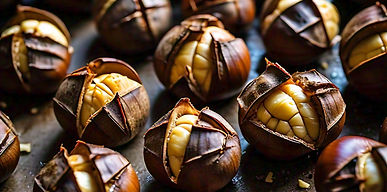

CHESTNUTS
Fall means chestnuts at Chasing Chickens Farm. We grow Dunstan Chestnuts, a hybrid chestnut tree resistant to blight and fungal disease that devastated the American Chestnut population.

Chestnut trees (Castanea spp.) release their nuts through a process called dehiscence, where the nut-bearing structure, called a burr or cupule, opens and drops its contents.
Stages of Dehiscence:
-
Maturation: Chestnuts mature and dry within the burr.
-
Burr splitting: The burr's spines begin to split, creating small openings.
3.Nut release: The chestnuts drop from the burr, often with a slight twisting motion.
Chestnut farmers often:
Monitor maturity: Check for splitting burrs and falling nuts.
Hand-picking: Collect nuts from the ground or trees.
Culinary Uses:
Dunstan Chestnuts are ideal for:
-
Roasting: Enhances natural sweetness and texture.
-
Boiling: Perfect for side dishes, soups, and stews.
-
Grilling: Adds smoky flavor to salads and stir-fries.
Nutritional Profile:
Similar to other chestnut varieties, Dunstan Chestnuts are:
-
High in fiber: Supports healthy digestion.
-
Rich in antioxidants: Contains vitamins C and E.
-
Good source of protein: 2-3 grams per ounce.

How to Roast Chestnuts
Roasting chestnuts in the oven:
Basic Steps:
-
Preheat oven: 425°F (220°C).
-
Prepare chestnuts: Rinse, dry, and score.
-
Season: Optional: salt, pepper, herbs, or spices.
-
Roast: 15-20 minutes, shaking halfway.
Detailed Instructions:
Step 1: Prepare Chestnuts
-
Rinse chestnuts in cold water.
-
Pat dry with paper towels.
-
Score* the chestnuts: Make a shallow cut on the rounded side, about 1/4 inch (6 mm) deep.
Step 2: Season (Optional)
-
Toss chestnuts with:
-
Salt and pepper
-
Herbs (e.g., thyme, rosemary)
-
Spices (e.g., garlic powder, paprika)
-
Olive oil or butter
-
Step 3: Roast
-
Spread chestnuts in a single layer on a baking sheet.
-
Roast for 15-20 minutes or until:
-
Shell starts to open
-
Meat is tender and caramelized
-
-
Shake the baking sheet halfway through.
Tips and Variations:
-
Cutting: Score* or cut an "X" on the rounded side to prevent bursting.
-
Temperature: 400°F (200°C) for a slower roast.
-
Time: Adjust based on chestnut size and desired doneness.
-
Flavor: Add aromatics like onions, garlic, or lemon slices.
-
Finishing: Drizzle with honey, olive oil, or chili flakes after roasting.
Safety Precautions:
-
Handle hot chestnuts carefully.
-
Watch for bursting: Chestnuts can explode if not scored.
Common Issues:
-
Undercooked: Increase roasting time.
-
Overcooked: Reduce roasting time.
-
Dryness: Adjust scoring or add moisture (e.g., lemon juice).
*Scoring Chestnuts for Roasting
Scoring chestnuts requires caution to avoid injuries. Follow these guidelines:
Cutting Hazards:
-
Sharp objects: Use sharp knives or kitchen scissors with care.
-
Cut away from body: Prevent accidental cuts.
-
Finger protection: Keep fingers away from blades.
Chestnut Handling:
-
Slippery surface: Chestnuts can be slippery; handle carefully.
-
Pressure: Avoid applying excessive pressure, which can cause chestnuts to burst.
Best Practices:
-
Cut on stable surface: Use a secure cutting board.
-
Score in well-lit area: Ensure visibility.
-
Avoid distractions: Focus on scoring.
Prevention:
-
Use proper cutting techniques
-
Handle chestnuts carefully
-
Stay focused
By following these safety guidelines, you'll enjoy safely scoring chestnuts for roasting.
Enjoy your delicious oven-roasted chestnuts!


